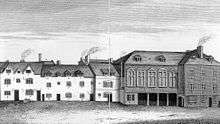James Neild
_by_Samuel_De_Wilde.jpg)
James Neild (4 June 1744 – 16 February 1814),[1] was a British prison reformer.
Neild was born in Knutsford, Cheshire,[1] where his family had some property. His father died, leaving five children, and his mother supported the family by carrying on business as a linendraper. After a very brief education Neild lived two years with an uncle, who was a farmer; but at the end of 1760 he obtained a situation with a jeweller in London, and was afterwards employed by Hemming, the king's goldsmith. Neild developed great mechanical skill, and also learned to engrave, model, and draw, as well as to fence. In 1770 a legacy from his uncle, the farmer, enabled him to set up in business as a jeweller in St. James's Street. The venture proved a success, and in 1792 he retired on a fortune.[1]
Neild retired to Chelsea, London,[2] and became a philanthropist and campaigner, especially in the field of prison reform.
Since his first settlement in London, Neild devoted his leisure to endeavours to reform the prisons of the country. When visiting in 1762 a fellow-apprentice who was confined for debt in the King's Bench, he had gained his first impression of the necessity of reform. Subsequently he inspected Newgate, the Derby prisons, Liverpool, Bridewell, the Chester dungeons, and before 1770 the prisons at Calais, St. Omer, Dunkirk, Lille, and Paris. The barbarous treatment to which prisoners were subjected in nearly all these places stirred Neild's energies, and on the formation in May 1773 of a Society for the Relief and Discharge of Persons imprisoned for Small Debts, Neild was appointed treasurer, and remained associated with the society till his death. In his capacity of treasurer he visited prisons in and about London, and made weekly reports. Fifteen months after the formation of the society 986 prisoners had been discharged, at a cost of a little less than ₤2,900.[1]
In 1779 Neild extended his inspection to Flanders and Germany. In 1781 he caught gaol fever at Warwick, and his ill-health, combined with business cares, for a time interrupted his philanthropic work. But in 1800 he published his ‘Account of Persons confined for Debt in the various Prisons of England and Wales … with their Provisionary Allowances during Confinement, as reported to the Society for the Discharge and Relief of Small Debtors.’ In the third edition, published in 1808, the results of further investigations in Scotland, as well as in England, were incorporated. He kept a diary of his tour, and wrote to his friend, Dr. John Coakley Lettsom, accounts of his experiences. These the latter prevailed on him to publish in the ‘Gentleman's Magazine,’ under the form of ‘Prison Remarks.’ They were prefaced by communications from Lettsom, and led to a great awakening of public interest. Gaolers were on the alert, and magistrates showed a keener sense of their responsibilities (cf. Gent. Mag. 1805 ii. 892–4, 1019, 1020, 1124–5, 1806 i. 19–24). In the latter half of 1809, during a four months' excursion in England and Scotland, Neild was presented with the freedom of Glasgow, Perth, Paisley, Inverness, and Ayr.[1]
In 1812, after inspecting a number of prisons, he published his State of Prisons in England, Scotland and Wales. Along with Jeremy Bentham's Punishments and Rewards (1811), Neild's book helped to trigger parliamentary pressure for reform.[3]
Neild was High Sheriff of Buckinghamshire in 1804.
Neild had married, in 1778, the eldest daughter of John Camden of Battersea. They had two sons and a daughter. On his death he was succeeded by his younger son John Camden Neild, his elder son being disinherited and having gone abroad. John Camden Neild lived the life of a recluse and on his death in 1852 left the whole of his fortune to the Queen.
See also
References
- 1 2 3 4 5
 This article incorporates text from a publication now in the public domain: "Neild, James". Dictionary of National Biography. London: Smith, Elder & Co. 1885–1900.
This article incorporates text from a publication now in the public domain: "Neild, James". Dictionary of National Biography. London: Smith, Elder & Co. 1885–1900. - ↑ Cheyne Walk, Chelsea
- ↑ Philpotts, Trey. Companion to Little Dorrit, Helm Information, 2003, p. 95.
| ||||||||||||||||||||||||
|
